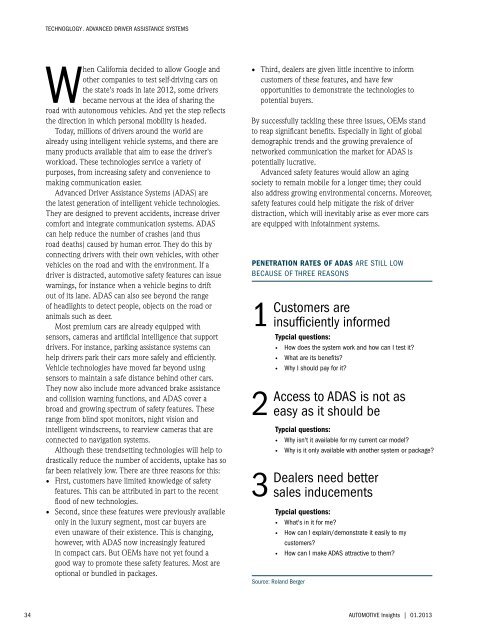Automotive Insights 01.2013 - Roland Berger
Automotive Insights 01.2013 - Roland Berger
Automotive Insights 01.2013 - Roland Berger
Create successful ePaper yourself
Turn your PDF publications into a flip-book with our unique Google optimized e-Paper software.
technoglogy . Advanced driver assistance systems<br />
When California decided to allow Google and<br />
other companies to test self-driving cars on<br />
the state's roads in late 2012, some drivers<br />
became nervous at the idea of sharing the<br />
road with autonomous vehicles. And yet the step reflects<br />
the direction in which personal mobility is headed.<br />
Today, millions of drivers around the world are<br />
already using intelligent vehicle systems, and there are<br />
many products available that aim to ease the driver's<br />
workload. These technologies service a variety of<br />
purposes, from increasing safety and convenience to<br />
making communication easier.<br />
Advanced Driver Assistance Systems (ADAS) are<br />
the latest generation of intelligent vehicle technologies.<br />
They are designed to prevent accidents, increase driver<br />
comfort and integrate communication systems. ADAS<br />
can help reduce the number of crashes (and thus<br />
road deaths) caused by human error. They do this by<br />
connecting drivers with their own vehicles, with other<br />
vehicles on the road and with the environment. If a<br />
driver is distracted, automotive safety features can issue<br />
warnings, for instance when a vehicle begins to drift<br />
out of its lane. ADAS can also see beyond the range<br />
of headlights to detect people, objects on the road or<br />
animals such as deer.<br />
Most premium cars are already equipped with<br />
sensors, cameras and artificial intelligence that support<br />
drivers. For instance, parking assistance systems can<br />
help drivers park their cars more safely and efficiently.<br />
Vehicle technologies have moved far beyond using<br />
sensors to maintain a safe distance behind other cars.<br />
They now also include more advanced brake assistance<br />
and collision warning functions, and ADAS cover a<br />
broad and growing spectrum of safety features. These<br />
range from blind spot monitors, night vision and<br />
intelligent windscreens, to rearview cameras that are<br />
connected to navigation systems.<br />
Although these trendsetting technologies will help to<br />
drastically reduce the number of accidents, uptake has so<br />
far been relatively low. There are three reasons for this:<br />
• First, customers have limited knowledge of safety<br />
features. This can be attributed in part to the recent<br />
flood of new technologies.<br />
• Second, since these features were previously available<br />
only in the luxury segment, most car buyers are<br />
even unaware of their existence. This is changing,<br />
however, with ADAS now increasingly featured<br />
in compact cars. But OEMs have not yet found a<br />
good way to promote these safety features. Most are<br />
optional or bundled in packages.<br />
• Third, dealers are given little incentive to inform<br />
customers of these features, and have few<br />
opportunities to demonstrate the technologies to<br />
potential buyers.<br />
By successfully tackling these three issues, OEMs stand<br />
to reap significant benefits. Especially in light of global<br />
demographic trends and the growing prevalence of<br />
networked communication the market for ADAS is<br />
potentially lucrative.<br />
Advanced safety features would allow an aging<br />
society to remain mobile for a longer time; they could<br />
also address growing environmental concerns. Moreover,<br />
safety features could help mitigate the risk of driver<br />
distraction, which will inevitably arise as ever more cars<br />
are equipped with infotainment systems.<br />
Penetration rates of ADAS are still low<br />
because of three reasons<br />
1<br />
2<br />
3<br />
Customers are<br />
insufficiently informed<br />
Typcial questions:<br />
• How does the system work and how can I test it<br />
• What are its benefits<br />
• Why I should pay for it<br />
Access to ADAS is not as<br />
easy as it should be<br />
Typcial questions:<br />
• Why isn't it available for my current car model<br />
• Why is it only available with another system or package<br />
Dealers need better<br />
sales inducements<br />
Typcial questions:<br />
• What's in it for me<br />
• How can I explain/demonstrate it easily to my<br />
customers<br />
• How can I make ADAS attractive to them<br />
Source: <strong>Roland</strong> <strong>Berger</strong><br />
34 <strong>Automotive</strong> <strong>Insights</strong> | <strong>01.2013</strong>
















